#the-decapod
Note
Running around in circles over August and Donnie and maybe the square hole piece of art
But! I noticed in the Good Timeline versus Bad Timeline post, August’s design looks slightly different in the outcome comparisons. Is there any larger design changes between the two?
Heehee <3
I'm glad someone caught that! The physical changes between good timeline and bad timeline August are mostly subtle. She keeps her own little eyebrows from her childhood in the good one, but draws her brows like Donnie in the bad as an homage to him. In the bad timeline she also wears a different outfit - a short dress-like fit with a hood - while in the good timeline teen August has pants. I tend to draw her more muscular in the bad timeline but she'd look overall healthier in the good one.
25 notes
·
View notes
Note
Heyo fellow aroace here. I have a friend whose absolutely obsessed with Epic if you want me to tag her.
Hiya! Always a pleasure to meet a fellow aroace 💚💜 I would love if you could tag her, so far I only have one of my in person friends hooked on it, I need more people to chat with about this masterpiece!
#hiya#how’s it going#aroace#jorge rivera herrans#epic: the musical#epic the musical#the-decapod#please#I need more people to talk to about epic#instead of just scrolling the tag#and the in person friend isn’t even that into it#like#she listens to it#but casually#and I tried to tell her how freaking awesome it is#but she just has other hyperfixations#which I get#BUT EPIC: THE MUSICAL
17 notes
·
View notes
Text
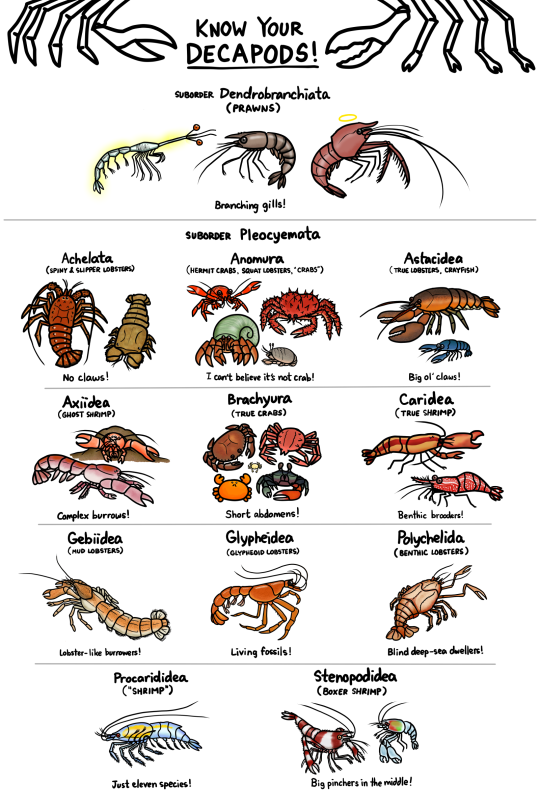
Decapocember Day 14: Know your Decapods!
Available as a print, just in time for holiday gift-giving!
3K notes
·
View notes
Text

27K notes
·
View notes
Text

drew this back in June, Eryon is ready to throw hands (claws)
#jurrasic june#jurrasic#paleoart#paleo art#palaeoblr#eryon#crustacean#decapod#extinct animals#prehistoric
2K notes
·
View notes
Text
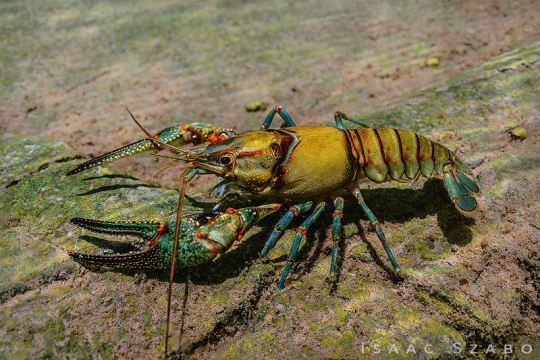
Longpincered Crayfish (Faxonius longidigitus), family Cambaridae, found in the White River basin of southern Missouri and northern Arkansas, USA
photograph by Isaac Szabo
598 notes
·
View notes
Text

Click here for a big ass database all about crustaceans. [No, they didn't sponsor me :( ]

#marine biology#crab#crab day#crustacean#decapod#crabs#decapoda#fiddler crab#adhd brain#hyperfixation#pirates#fishblr
399 notes
·
View notes
Text
Taxonomy Tournament: Crustaceans


Decapods. This order includes crabs, lobsters, crayfish, shrimp, and prawns.
Isopoda. This order is made up of isopods, including terrestrial species like the potato bug and aquatic species like the giant isopod. Some eat dead matter, others are filter feeders, and some are parasites, mostly of fish.
#10 vs =#animals#biology#polls#poll tournament#zoology#crabs#lobsters#crayfish#shrimp#prawns#arthropods#crustaceans#ecdytes#isopods#animal parasite#Decapods#Isopoda#0x32v0x4d
276 notes
·
View notes
Text
Wet Beast Wednesday: pistol shrimp
Oh snap, it's the snapping shrimp post for Wet Beast Wednesday! Snapping shrimp or pistol shrimp are loud little critters that have evolves a very useful and fascinating tool in their pincers. Let's not waste time and shoot off to learn about these little gunslingers.
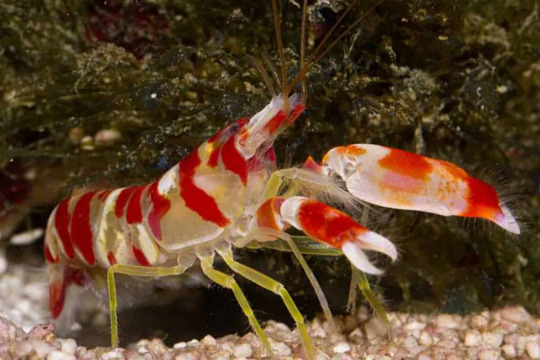
(Image: a pistol shrimp. It is a mostly white shrimp with red stripes. One of its claws is considerably larger than the other. It is standing on gravel and next to some seaweed. End ID)
Pistol shrimp are over 1,000 members of the family Alpheidae, which is part of the infraorder Caridea. This means they are true shrimp, not to be confused with superficially similar animals like brine shrimp, mantis shrimp, tadpole shrimp, and prawns. Yeah, I only recently learned that prawns and shrimp aren't a language difference between British English and American English like chips vs fries. They're not even that closely related. As true shrimp, pistol shrimp have two main body parts: the cephalothorax and abdomen, which are composed of 19 body segments. The abdomen forms a flexible tail with a fin on the end. When startled, the fin can rapidly curl under the body, propelling the shrimp backwards. Like other decapods, there are 10 limbs. The front pair of limbs have evolved into claws used to manipulate objects. The claws are the most distinguishing feature of pistol shrimp. They are asymmetrical, with one growing extremely large, over half the size of the body. The big claw has a modified version of the typical pincer. This pincer has an upper claw that can open up at a right angle. Under the claw is a pocket in the lower pincer, into which water flows. The upper pincer then slams down into this pocket, forcing the water out. The pressure of the pincer closing water in the pocket creates a cavitation bubble that is forced away from the claw at up to 26.8 meters per second. This is enough force to seriously wound small animals and hurt larger ones into leaving the shrimp alone. The cavitation bubbles can reach up to 4,427 degrees C (8,000 F) . For comparison, the surface of the sun is about 1,000 decrees (C) hotter. When the bubble pops, it creates a snapping sound that can reach 218 decibels. For comparison, most gunshots max out at around 170 db. This puts pistol shrimp is the running for the loudest ocean animals, with whales being the other main competitors. If that all sounds like a lot, the whole event happens so fast that the heat doesn't have time to affect much and the noise sounds like a moderately loud snap to us. Adults can snap their claws shut with an acceleration of up to 30 meters per second squared and juveniles can do it up to 20 times faster. The whole process takes less than a millisecond. When the cavitation bubble collapses, it can produce light. This is called sonoluminescence and nobody knows how it happens. If a pistol shrimp loses its large claw, the small claw will grow into a new large one while the missing limb will regenerate into a small claw. Adult pistol shrimp average between 3 and 5 cm long.
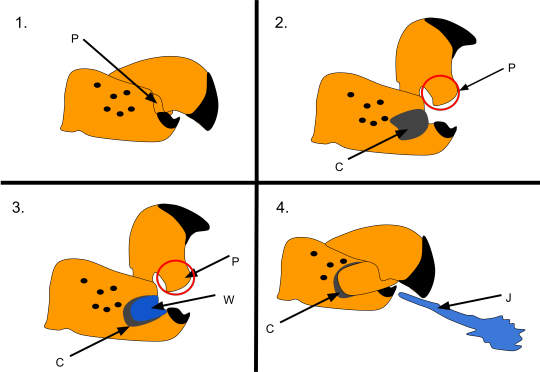
(Image: a drawing showing the process of a pistol shrimp snapping its claw. In the first panel, the claw is closed. In the second, the upper claw opens at a 90 degree angle, revealing a cavity. In the third panel, the cavity fills with water. In the final panel, the claw is closed again and a jet of water is ejected from the claw. End ID. Source: Wikipedia user Carermyers)
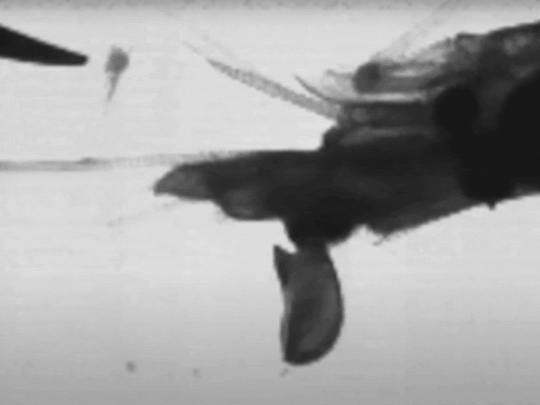
(Gif: black and white, slow-motion video of a pistol shrimp's claw snapping shut and creating a cavitation bubble. End ID. Source)
Pistol shrimp live worldwide, though most species live in tropical or temperate water. There are some cold water species and even freshwater species. Most prefer habitats where they can make burrows and where there are plenty of other animals. Coral reefs, oyster reefs, seagrass beds, mangrove groves are common habitats. Snapping is used for hunting and communication. They typically hide in burrows, waiting for fish or other small animals to pass by. When prey passes, the shrimp will snap to stun or seriously wound the prey, then drag it into the burrow. Some social species actually form eusocial hives with a single queen who produces all offspring. These shrimp are the only known marine eusocial species and all occur within the same genus (Synalpheus), though not every member of that genus is eusocial and eusociality appears to have evolved at least 3 times within that genus. It appears that a reason why only this genus developed eusociality is their larvae do not disperse, instead staying in the same area as the parents. The hives are usually located within sponges. Other social species are not eusocial, but still live together in colonies. Many less social species have formed a symbiotic relationship with gobies. Both species live in burrows, but gobies are bad at digging while the shrimp have poor eyesight. The goby will protect the shrimp while it digs a burrow, then the two live together. They will forage together, with the goby using its superior eyesight to watch for predators and warn the shrimp to get back to the burrow. Pistol shrimp are monogamous, the same pair coming back to mate over and over again (this does not apply to the eusocial species in which only the colony's queen is permitted to mate). The female is only fertile during a short period after molting. The male will stay with the female and protect her during the vulnerable period after mating and some species will remain with each other until the eggs hatch or permanently.
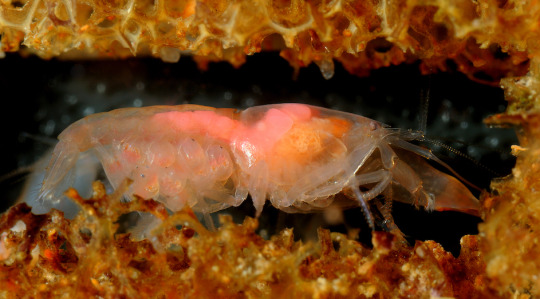
(Image: a eusocial pistol shrimp queen with eggs. Her body is translucent and multiple eggs are attached to her abdomen. The eggs look like translucent balls. The is inside of an orange sponge. End ID)
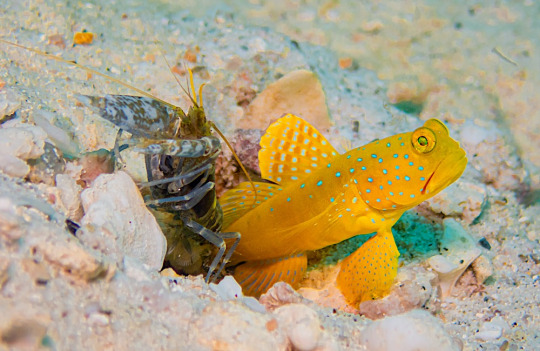
(Image: a pistol shrimp and goby emerging from a burrow in the sand. The shrimp is a mottled green and white. The body is a bright yellow fish covered with blue spots. End ID)
Pistol shrimp are a major source of noise in the places where they live. If you've ever been swimming and can hear repeated cracking noises, that may have been a bunch of pistol shrimp. Some scientists monitor the level of pistol shrimp noises as a method of monitoring the ecosystem. If the noise level drops, that is an indicator that the local ecosystem is suffering. The noise of the shrimps can get so loud that it actually interferes with sonar and forms of underwater communication. During World War II, members of the navy realized that the shrimp disrupted sonar enough to hide submarines, so they started hiding submarines near reefs with lots of the shrimp to keep them from being found by enemy subs. Weirdly not the only small marine animals to mess with submarines. I'll get the the other major one soon. The largest threats to pistol shrimp come from habitat destruction. Some species of pistol shrimp have entered the pet trade. As coral reefs, seagrass beds, and other habitats are destroyed, the shrimp that rely on them will suffer as well.

Yet another time I get to use one of these cards in a post
(Image: the Weird n' Wild Creatures card featuring pistol shrimp. End ID)
#wet beast wednesday#pistol shrimp#snapping shrimp#shrimp#decapod#crustaceans#marine biology#biology#zoology#ecology#animal facts#eusocial#symbiosis#goby#informative#image described
235 notes
·
View notes
Text
Nostalgia for yesteryear
Well, the Tumblr Booper-Fool's Day is very, very appropriate for the userbase. However, I more than a bit nostalgic for the crabs. Do-it-yourself it is, then!


This is a mix of top-stitching and applique techniques that might not go over very well in a formal quilt competition, but all my work is for home use only. I stitch according to my fickle heart.
Feel free to reblog and tag a friend to 'crab' them in addition to the Booping!
(He's shiiiiiiiiny,)
#april fool's day#artblr#artist#crab#time for crab#quilt#quiltblr#quilting#sewing sewblr#hexagonal decapod#he doesn't have the full number of legs because I have Limits!
281 notes
·
View notes
Text
Uncharismatic Fact of the Day
Oysters are often valued for the pearls they may contain, but some oysters hold a treasure even more valuable-- the pea crab! It's thought to be the smallest crab in the world, about 6-13 mm (0.2-0.5 in) wide, and they can be found inside a variety of mollusks, where they feed on the food that filters in through their host's gills.

(Image: A pea crab (Pinnotheres pisum) inside a mollusk host by Filip Nuyttens)
If you send me proof that you’ve made a donation to UNRWA or another organization benefiting Palestinians– including esim donations– I’ll make art of any animal of your choosing.
223 notes
·
View notes
Text

Strange Symmetries #13: The Hermit Crab Cycle
Hermit crabs are crustaceans that first appeared at the start of the Jurassic, about 201 million years ago. Despite their common name they aren't actually true crabs, instead being a classic example of convergently evolving a crab-like body plan via carcinization.
They also have noticeably asymmetric bodies, with abdomens that coil to one side and differently-sized front claws.

Pagurus bernhardus by Arnstein Rønning | CC BY 3.0
And while modern hermit crabs are famous for inhabiting scavenged snail shells, their fossil record suggests this wasn't always the case.
Originally, they seem to have lived in ammonite shells.
Palaeopagurus vandenengeli lived in what is now northern England during the Early Cretaceous, about 130 million years ago. Around 4-5cm long (~1.6-2"), it was found preserved inside the shell of the ammonite species Simbirskites gottschei.
Its left claw was much larger than its right, and together they would have been used to block the shell opening when it was hiding away inside. And while the exact shape of its abdomen isn't known, it probably asymmetrically coiled to the side to accomodate the spiralling shape of the host shell.
Hermit crabs seem to have switched over to using gastropod shells by the Late Cretaceous, around 90-80 million years ago, possibly due to marine snails developing much stronger sturdier shells during this period in response to the increasing prevalence of specialized shell-crushing predators. The more upright snail shells would also have been much easier to drag around the seafloor than ammonite shells – and meant that they were ultimately less affected by the total disappearance of ammonites during end-Cretaceous mass extinction.
———
NixIllustration.com | Tumblr | Twitter | Patreon
#science illustration#strange symmetries#paleontology#paleoart#palaeoblr#palaeopagurus#paguridae#paguroidea#hermit crab#anomura#decapod#crustacea#arthropod#invertebrate#art#carcinization
981 notes
·
View notes
Text

My Russian Decapod oc which I drew at work
He's tired and went through a lot, poor thing
#ttte oc#maqui's sketchbook#ink drawing#traditional art#traditional drawing#russian decapod#ivan the siberian engine#locomotive#steam locomotive
88 notes
·
View notes
Text
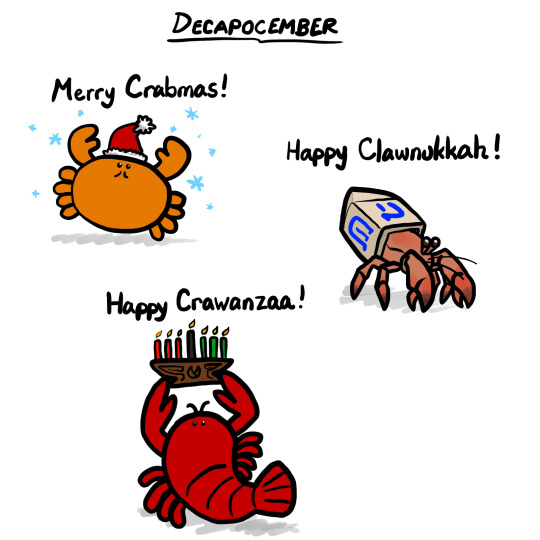
December is for Decapods!
5K notes
·
View notes
Text
Remember this post I made?
Well I'm back with something pretty special: Some pictures of the diagrams from said book! The book is Trinidad Naturalist Volume 2 No. 12, and it was published in November/ December of 1979!


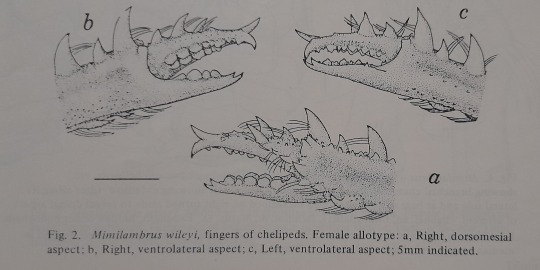
[Image ID: Several diagrams of a crab, showing the closeup of the palps and claws. The paper is slightly brownish, showing that the book have considerable age. /End ID]
@revretch, @bogleech and maybe @vintagewildlife, I think you'll be interested in this? Especially since this book have interesting pictures in some of the articles as well.
#OCTAfan says stuff#vintage illustration#scientific illustration#Crab#Decapod#Mimilambrus Wileyi#Ask to tag
101 notes
·
View notes
Text


Photos 1-2 - Specimen 1


Photos 3-4 - Specimen 2


Photos 5-6 - Specimen 3
D. senex hermit crabs residing in empty Moon Snail shells.
13/08/23 - Diogenes senex
QLD:WET - Flying Fish Point, low tide sandy bay
#invertblr#invertebrates#Arthropods#Arthropoda#Diogenes senex#Paguroidea#Hermit Crabs#Decapoda#Decapods#Crustacea#Crustaceans#hermit crabs#crabs
60 notes
·
View notes